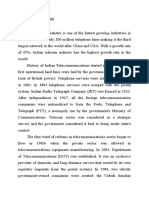0% found this document useful (0 votes)
94 views5 pagesMobile Subscribers: Telecom Industry: An Overview
The telecom industry in India is the second largest in the world with over 671 million subscribers as of 2010. It has experienced rapid growth with mobile subscribers increasing at a compound annual growth rate of 33.44% between 1998 and 2009. While mobile penetration reached 44.9% by 2009, two-thirds of India's population in rural areas remains underpenetrated, representing significant growth opportunities. The industry is dominated by a few major players like Bharti Airtel, Reliance, and Vodafone, with BSNL maintaining a leading position in fixed-line and rural segments. Overall tele-density in India reached 52.74% by 2010, and the sector is expected to generate over 3 l
Uploaded by
pgp25107Copyright
© Attribution Non-Commercial (BY-NC)
We take content rights seriously. If you suspect this is your content, claim it here.
Available Formats
Download as DOCX, PDF, TXT or read online on Scribd
0% found this document useful (0 votes)
94 views5 pagesMobile Subscribers: Telecom Industry: An Overview
The telecom industry in India is the second largest in the world with over 671 million subscribers as of 2010. It has experienced rapid growth with mobile subscribers increasing at a compound annual growth rate of 33.44% between 1998 and 2009. While mobile penetration reached 44.9% by 2009, two-thirds of India's population in rural areas remains underpenetrated, representing significant growth opportunities. The industry is dominated by a few major players like Bharti Airtel, Reliance, and Vodafone, with BSNL maintaining a leading position in fixed-line and rural segments. Overall tele-density in India reached 52.74% by 2010, and the sector is expected to generate over 3 l
Uploaded by
pgp25107Copyright
© Attribution Non-Commercial (BY-NC)
We take content rights seriously. If you suspect this is your content, claim it here.
Available Formats
Download as DOCX, PDF, TXT or read online on Scribd
/ 5






















































































